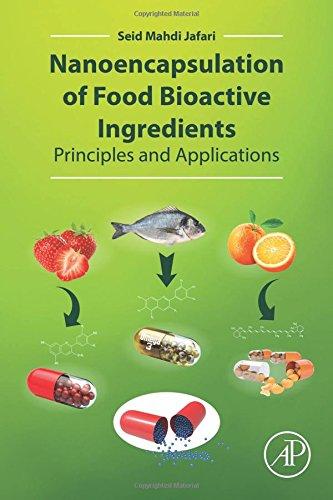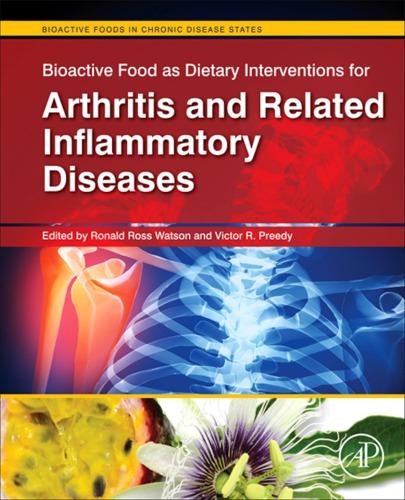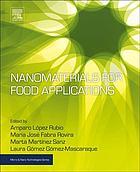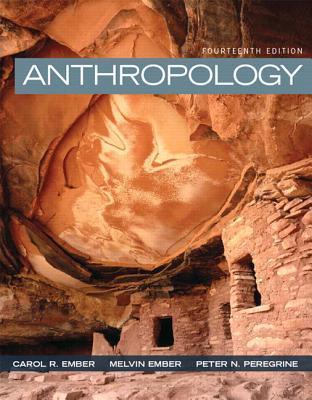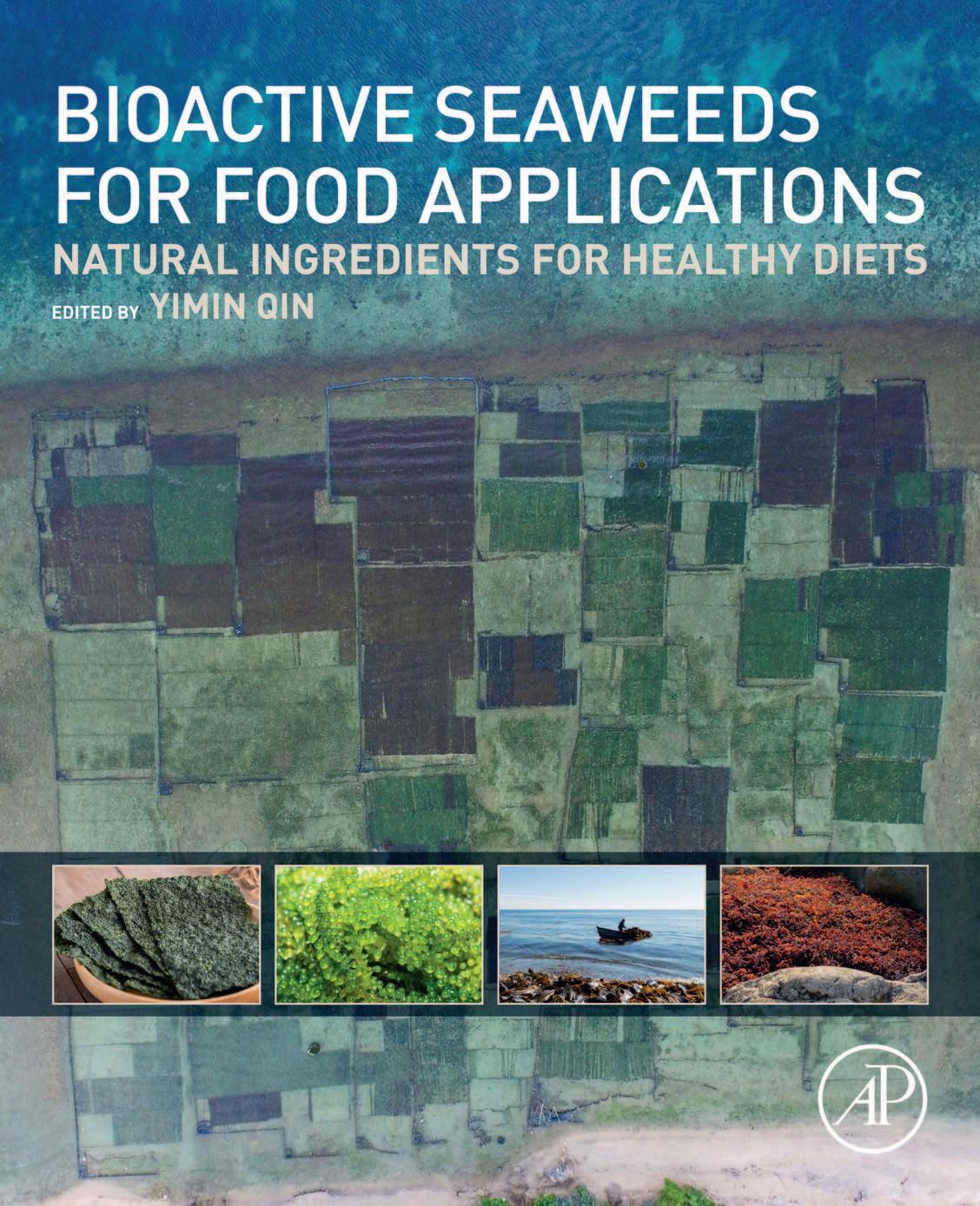Bioactive Seaweeds for Food Applications
Natural Ingredients for Healthy Diets
Edited by Yimin Qin
Academic Press is an imprint of Elsevier 125 London Wall, London EC2Y 5AS, United Kingdom 525 B Street, Suite 1800, San Diego, CA 92101-4495, United States 50 Hampshire Street, 5th Floor, Cambridge, MA 02139, United States The Boulevard, Langford Lane, Kidlington, Oxford OX5 1GB, United Kingdom
Copyright © 2018 Elsevier Inc. All rights reserved.
No part of this publication may be reproduced or transmitted in any form or by any means, electronic or mechanical, including photocopying, recording, or any information storage and retrieval system, without permission in writing from the publisher. Details on how to seek permission, further information about the Publisher’s permissions policies and our arrangements with organizations such as the Copyright Clearance Center and the Copyright Licensing Agency, can be found at our website: www.elsevier.com/permissions.
This book and the individual contributions contained in it are protected under copyright by the Publisher (other than as may be noted herein).
Notices
Knowledge and best practice in this field are constantly changing. As new research and experience broaden our understanding, changes in research methods, professional practices, or medical treatment may become necessary.
Practitioners and researchers must always rely on their own experience and knowledge in evaluating and using any information, methods, compounds, or experiments described herein. In using such information or methods they should be mindful of their own safety and the safety of others, including parties for whom they have a professional responsibility.
To the fullest extent of the law, neither the Publisher nor the authors, contributors, or editors, assume any liability for any injury and/or damage to persons or property as a matter of products liability, negligence or otherwise, or from any use or operation of any methods, products, instructions, or ideas contained in the material herein.
Library of Congress Cataloging-in-Publication Data
A catalog record for this book is available from the Library of Congress
British Library Cataloguing-in-Publication Data
A catalogue record for this book is available from the British Library
ISBN: 978-0-12-813312-5
For information on all Academic Press publications visit our website at https://www.elsevier.com/books-and-journals
Publisher: Andre Gerhard Wolff
Acquisition Editor: Patricia Osborn
Editorial Project Manager: Karen R. Miller
Production Project Manager: Bharatwaj Varatharajan
Cover Designer: Matthew Limbert
Typeset by TNQ Books and Journals
8. Seaweed-Derived Hydrocolloids as Food Coating and Encapsulation Agents 153
Demeng Zhang, Mengxue Zhang and Xiaoxiao Gu
8.1 Introduction 153
8.2 Seaweed Hydrocolloids as Food Coating and Film Agents 155
8.3 Seaweed-Derived Hydrocolloids as Food encapsulation Agents 160
8.4 Conclusions 168 References 168
PART III Health Benefits of Bioactive Seaweed Substances
9. Health Benefits of Bioactive Seaweed Substances 179
Yimin Qin
9.1 Introduction 180
9.2 A Brief Description of the Bioactive Seaweed Substances 180
9.3 Health Benefits of Dietary Seaweeds 181
9.4 Health Benefits of Bioactive Seaweed Substances 183
9.5 Summary 195 References 196 Further Reading 199
10. Antioxidant Properties of Seaweed-Derived Substances 201
Ditte B. Hermund
10.1 Introduction 201
10.2 Antioxidants and their Mechanisms 202
10.3 Antioxidant Substances From Seaweed 203
10.4 Phlorotannins 206
10.5 Antioxidant Strategies, now and in the Future 212
10.6 Future Perspective 217 References 217
11. Fucoidan and Its Health Benefits
Peili Shen, Zongmei Yin, Guiyan Qu and Chunxia Wang 11.1
11.2 extraction of Fucoidan From Brown Seaweeds
11.3 Chemical and Physical Characteristics of Fucoidan
11.4 Biological and Physiological Functions of Fucoidan
11.5 Health Benefits and Potential Applications of Fucoidan
11.6
12. Antiobesity, Antidiabetic, Antioxidative, and Antihyperlipidemic Activities of Bioactive Seaweed Substances
Zhanyi Sun, Zengying Dai, Wenchao Zhang, Suqin Fan, Haiyan Liu, Ranran Liu and Ting Zhao
12.1
12.2
12.3
12.4
12.5 Antihyperlipidemic Activity of Bioactive Seaweed Substances
12.6
13. Absorption of Heavy Metal Ions by Alginate 255
Lili Zhao, Jue Wang, Pengpeng Zhang, Qiaoqiao Gu and Chuancai Gao
13.1
13.2
13.4
List of Contributors
Zengying Dai Qingdao Brightmoon Seaweed Group, Qingdao, China
Suqin Fan Qingdao Brightmoon Seaweed Group, Qingdao, China
Chuancai Gao Qingdao Brightmoon Seaweed Group, Qingdao, China
Qiaoqiao Gu Qingdao Brightmoon Seaweed Group, Qingdao, China
Xiaoxiao Gu Qingdao Brightmoon Seaweed Group, Qingdao, China
Ditte B. Hermund Technical University of Denmark, Kongens Lyngby, Denmark
Efstathia Ioannou National and Kapodistrian University of Athens, Athens, Greece
Jinju Jiang Qingdao Brightmoon Seaweed Group, Qingdao, China
Aikaterini Koutsaviti National and Kapodistrian University of Athens, Athens, Greece
Haiyan Liu Qingdao Brightmoon Seaweed Group, Qingdao, China
Ranran Liu Qingdao Brightmoon Seaweed Group, Qingdao, China
Ratih Pangestuti Indonesian Institute of Sciences, Jakarta, Republic of Indonesia
Seema Patel San Diego State University, San Diego, CA, United States
Yimin Qin Qingdao Brightmoon Seaweed Group, Qingdao, China
Guiyan Qu Qingdao Brightmoon Seaweed Group, Qingdao, China
Vassilios Roussis National and Kapodistrian University of Athens, Athens, Greece
Peili Shen Qingdao Brightmoon Seaweed Group, Qingdao, China
Shaojuan Shi Qingdao Brightmoon Seaweed Group, Qingdao, China
This page intentionally left blank
Preface
Bioactive seaweed substances are a group of chemical components extracted from seaweed biomass, which can influence the biological processes of living organisms through chemical, physical, biological, and other mechanisms. These substances include biomass components in the extracellular matrix, cell wall, plasma, and other parts of the seaweed cells generated through primary and secondary metabolism, of which the primary metabolites are generated when the seaweed cells process nutrients through biodegradation or biosynthesis, such as amino acids, nucleotides, polysaccharides, lipids, vitamins, etc., whereas secondary metabolites are those chemicals modified from primary metabolites, including genetic materials, medicinal materials, biotoxins, functional materials, and other seaweed-based substances. There is a long history of the applications of bioactive seaweed substances in functional food products. Seaweed-derived hydrocolloids have long been used as food ingredients. In particular, the unique biophysical properties of alginate and carrageenan are highly valuable in the development of functional food products. As food ingredients, the applications of alginate and carrageenan are based on three main properties, i.e., thickening, gelling, and film forming. In particular, the unique gelling abilities at low temperature alongside good heat stability make alginate ideal for use as thickeners, stabilizers, and restructuring agents. Recently, alginate is increasingly used in a myriad of newer applications, from encapsulating active enzymes and live bacteria to acting as the carrier for protective coating of prepacked, cut, or prepared fruits and vegetables. With novel chemical and biological modifications to alter its structures and properties, there are possibilities of novel applications of specific alginates in the food industry that have high bioactivities at low concentrations. In general, seaweed-derived functional foods can provide health benefits by reducing the risk of chronic diseases and enhancing the ability to manage chronic diseases, thus improving the quality of life. They can also promote growth and development and enhance performance.
Marine nutraceuticals can be derived from the many varieties of seaweeds. For example, fucoidan is a complex fucose-rich sulfated carbohydrate, which can be extracted from brown seaweeds. This biologically active carbohydrate has been shown to inhibit a wide range of cancer cell lines, and studies in mice indicate that anticancer effects are also seen in vivo. As a marine nutraceutical product, fucoidan has been used in many health products and is important for its high bioactive properties, for example, antibacterial, anticoagulant, antiviral, antitumor, etc. Seaweeds and marine microalgae are natural sources for β-carotene, astaxanthin, and eicosapentaenoic acid that have high bioactivities and are an important part of nutraceutical products, playing a significant role in a number of aspects of human health.
Looking into the future, bioactive seaweed substances are valuable in a group of industries including pharmaceuticals, nutraceuticals, functional foods, biomedical materials, cosmetics, and fertilizers, in addition to the traditional applications in textiles, chemicals, and environmental protection. Once extracted, separated, and purified, the various types of bioactive seaweed substances can be screened for their bioactivities and utilized in an appropriate application. Modern technologies can allow the separation of these native ingredients into purified chemical compounds. Once structurally characterized and functionally assessed, the highly active compounds can be applied in marine drugs, whereas those with lower activities can be
Acknowledgments
The ever-increasing human population and its standard of living have placed new demand for more and healthier resources for food and its ingredients. With more than 70% of the globe’s surface, ocean-derived biomass and related biomaterials are not only vast in quantity, but they are also structurally diverse with many unique biological activities. Marine species comprise approximately one half of the total global biodiversity and the ocean offers an enormous resource for novel compounds that can be explored for their health and nutritional benefits. Among the many marine organisms thriving in the vast ocean, seaweeds represent a bioresource that is both old and new. Historically, seaweeds have been explored for their bioactivities in many parts of the world dating back to ancient times. In China, where the homology of medicine and food has been recognized for over 2000 years, the health benefits of seaweeds were recognized in ancient medicinal books such as Sheng Nong’s Herbal Classic, Supplementary Records of Famous Physicians, Marine Herbal, Compendium of Materia Medica, etc.
Modern science and technology have uncovered the many bioactive seaweed substances and allowed their separation and purification into high-valued bioproducts, which are now widely used in a wide range of health-related industries. The natural and cultivated seaweeds are a unique source of raw materials for the production of seaweed-based bioproducts. They have large scale varieties, and are green, environmentally friendly, and renewable. In addition, seaweed biomass and the natural products derived from them are hydrophilic, biocompatible, and biodegradable, and contain many substances with high bioactivities, which are important supplement to land-based resources.
To fully explore the many bioactive seaweed substances and develop them into an environmentally friendly and sustainable industrial chain, in particular with a view of promoting their applications in functional food products, we set out to write this book and, after a year of hard work, I am glad that we have been able to compile the many sources of information into this book. As an editor, I am grateful to the following people who have made the successful completion of this book:
Patricia Osborne and Karen Miller at Elsevier who project managed the manuscript preparation processes;
Dr. A. Koutsaviti, Dr. E. Ioannou, Dr. V. Roussis, Dr. S. Patel, Dr. R. Pangestuti, Dr. E. A. Siahaan and Dr. D. B. Hermund who wrote excellent chapters for this book;
I am also indebted to the State Key Laboratory of Bioactive Seaweed Substances at Qingdao Brightmoon Seaweed Group for providing the resources that made this book possible. In particular, I would like to thank Mr. Guofang Zhang, chairman of BMS Group for his support to this project; Mr. Kechang Li, deputy CEO, for providing important data to this book; and Mr. Fahe Wang, Technical Manager, for his assistance during manuscript preparation. I am also grateful to the group of scientists at the State Key Laboratory, Demeng Zhang, Lili Zhao, Jinju Jiang, Peili Shen, Zhanyi Sun, Zongmei Yin, Guiyan Qu, Chunxia Wang, Zengying Dai, Wenchao Zhang, Suqin Fan, Haiyan Liu, Ranran Liu, Ting Zhao, Jue Wang, Pengpeng Zhang, Kuntian Feng, Qiaoqiao Gu, and Shaojuan Shi, for their contribution to this book.
Editor August 30, 2017
This page intentionally left blank
Seaweed Bioresources
1.1 Marine Biomass
Biomass is the mass of living biological organisms in a given area or ecosystem at a given time. Among the many varieties of microorganisms, plants, and animals that form the overall quantity of biomass on earth, marine biomass represents a relatively underexplored resource, which is attracting much attention in recent years partly because of the over exploration of land-based resources. The ever increasing human population and its standard of living have dramatically increased the global demand for living space, food, energy, and other natural resources from the earth. As oceans cover more than 70% of
our planet’s surface, attention has been directed toward the utilization of ocean-based resources, with the emergence of the so-called blue economy aimed at the comprehensive development of ocean-based resources and products (Charette and Smith, 2010; Gage and Tyler, 1991; Steele, 1985; Pietra, 2002).
Marine biomass, both natural and cultivated, is not only vast in quantities, but also structurally diverse with many unique biological activities. With marine species comprising approximately one half of the total global biodiversity, the world’s oceans offer an enormous resource for novel substances that are important for human health. Right now, more than 20,000 new substances have been isolated from marine organisms, with a wide range of applications from pharmaceutical products to functional foods (Hu et al., 2012). Different kinds of substances have been procured from marine biomass because marine environment gives the many organisms thriving in the vast ocean unique genetic structures and life habitats, opening the door to the development of many more novel bioactive substances that can be utilized in food, beverage, pharmaceutical, cosmetics, textiles, leather, electronic, medicine, biotechnology, and many other industries ( Thakur and Thakur, 2006; Kim, 2015).
1.2 Marine Algae
Algae are quantitatively the largest biomass in the ocean (Nedumaran and Arulbalachandran, 2015; Chapman, 2013). The term algae refers to a large and diverse assemblage of organisms that contain chlorophyll and carry out oxygenic photosynthesis. Biologically, algae represent a segment of the ocean’s food chain, which proceeds from phytoplankton to zooplankton, predatory zooplankton, filter feeders, predatory fish, and beyond. Among these different varieties of marine organisms, cyanobacteria are the smallest known photosynthetic organisms, with Prochlorococcus at just 0.5–0.8 μm in diameter. However, Prochlorococcus is probably the most plentiful species on earth with a single milliliter of surface seawater containing 100,000 cells or more.
Although most marine algae are microscopic in size and are thus considered to be microorganisms, several forms are macroscopic in morphology and are commonly known as seaweeds. One common characteristic is that all types of algae contain chlorophyll a and the colonial forms of algae occur as aggregates of cells, with each of these cells sharing common functions and properties, including the storage products they utilize as well as the structural properties of their cell walls. The presence of phytopigments other than chlorophyll a is a characteristic of a particular algal division. The nature of the reserve polymer synthesized as a result of photosynthesis is also a key variable used in algal classification. Accordingly, their divisions include Cyanophyta, Prochlorophyta, Phaeophyta, Chlorophyta, Charophyta, Euglenophyta, Chrysophyta, Pyrrophyta, Cryptophyta, and Rhodophyta (Sahoo, 2016). When comparing Phaeophyta (brown algae) to other common algal divisions such as the Rhodophyta (red algae), important differences are seen in the storage products they utilize as well as in their cell wall chemistry. In the Phaeophyta (brown algae), laminaran is the main storage product, whereas the Rhodophyta (red algae) is distinguished by the floridean starch it produces and stores.
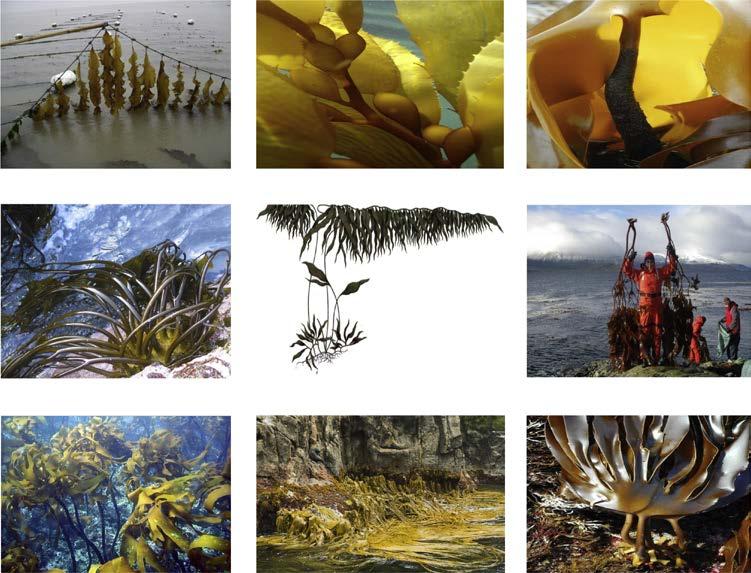







FIGURE 1.2 Main types of brown seaweeds used for alginate production.
FIGURE 1.3 Harvest of wild brown seaweeds in 2014.
